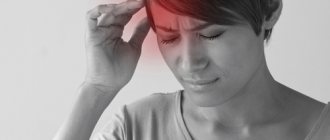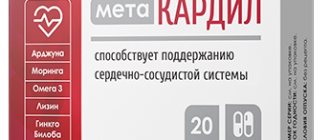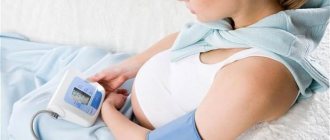Hypertension - causes and mechanism of development
Hypertension is a chronic disease in which there is a frequent increase in blood pressure. If normally it is 120/80 mm. rt. Art., then at 140/90 mm. rt. Art. The initial stage of the disease has already been diagnosed. In some patients, only the systolic (upper) pressure increases, but the lower (diastolic) pressure may also increase along with it. The diagnosis is made based on the results of measuring blood pressure in different physiological states: during rest and after exercise.
Blood pressure increases due to dysregulation, vascular spasms and other factors. In most patients, hypertension is primary - it manifests itself as an independent disease, and a hereditary predisposition can also be observed. In other cases, the disease is caused by long-term use of certain groups of drugs, including hormonal drugs, kidney disease and metabolic disorders. Thus, secondary (symptomatic) hypertension is diagnosed, which also often causes headaches and high blood pressure.
Doctors identify risk factors that can provoke attacks of hypertension, as well as aggravate the course of the disease in the early stages. These include:
- overweight – up to 85% of patients diagnosed with chronic hypertension suffer from obesity;
- smoking - this bad habit reduces the ability of blood vessels to respond to changes in blood pressure, and also provokes ischemia (oxygen starvation) of the myocardium;
- insufficient physical activity, sedentary lifestyle, working behind a monitor;
- stressful situations that activate the sympathetic nervous system and lead to a persistent increase in blood pressure;
- patient's age.
According to statistics, in young people hypertension is secondary and is associated with a person’s lifestyle. High blood pressure and headaches are often triggered by bad habits, stress and poor diet. At the age of 40 years and older, sclerotization of the arteries is diagnosed - a decrease in their strength and elasticity as a result of the growth of connective tissue. This process is irreversible, but can be reversed by taking medications, adequate exercise and a therapeutic diet.
What means
Blood pressure 120 over 80 - what does this mean? To do this, you need to know what these values mean:
- 120 mmHg Art. – systolic pressure, showing the level of blood pressure on the walls of the arteries at the moment of the onset of contractile movement of the myocardium;
- 80 mmHg Art. – diastolic pressure, showing the level of blood pressure on the walls of the arteries at the moment of completion of the contractile movement of the myocardium.
Thus, blood pressure (blood pressure) is an indicator of the force of blood pressure on the walls of blood vessels. Normal blood pressure is considered to be 120/80. But at the same time, for each person there is an individual norm, depending on certain factors. The main ones are:
- the speed at which myocardial contraction occurs;
- the volume of blood pumped by the heart over a certain time period;
- strength of resistance of vascular walls.
It is the stability of the listed indicators that sets the norm of blood pressure. Other factors may also have an additional influence. This is the person’s age group, the presence of chronic diseases, hormonal imbalances, and current psycho-emotional state.
Due to this, blood pressure levels can change throughout life. In a small child they will be quite low, but then - as they grow older - they will begin to rise and reach the accepted physiological (age) group.
Changes in hormonal levels can also provoke surges in blood pressure. That is why frequent changes in pressure during pregnancy and in adolescents are an acceptable norm and indicate an ongoing adaptation of the circulatory system.
During pregnancy, blood pressure readings of 120/80 are considered the absolute norm.
During pregnancy
Blood pressure of 120-127 over 80 during pregnancy is normal, if before pregnancy it was slightly lower. Changes in indicators will occur throughout the gestational period:
- during the first trimester (1–12 weeks), blood pressure may decrease, which is explained by the restructuring of all body systems;
- from the 18th week of gestation, the blood pressure level returns to the pre-pregnancy norm, but may increase slightly;
- By the end of the second trimester (26–27 weeks of pregnancy), blood pressure rises - if a woman does not experience headaches and feels well, then this should be considered as an acceptable norm.
Important! If an increase in blood pressure disrupts general well-being, then the pregnant woman requires medical attention.
Adults and elderly people
The physiological norm of blood pressure in women is somewhat different from that in men. Women's indicators are usually lower by about 6 mmHg. Art. This is due to hormonal fluctuations. For this reason, in old age, female hypertension is somewhat less common. In older people, “healthy” blood pressure levels will be higher. Physiological indicators – 146/158…83/84 mm Hg. Art. A blood pressure of 120/80 means the person is suffering from hypotension.
Children and teenagers
Blood vessels in childhood and adolescence are slightly more distensible than in adults. For this reason, their blood pressure levels are lower and this is a physiological norm. The younger the child, the lower his blood pressure.
Immediately after birth, the baby's blood pressure averages 70/45 mmHg. Art. Minor fluctuations are allowed. Then the indicators begin to gradually increase. At first, babies mature evenly, but when they reach a certain age, blood pressure levels may begin to differ.
For girls this is the age of 3–4 years, 12–14 years. For boys, these ages are 5–8 and 16 years. A blood pressure of 120/80, diagnosed in childhood, cannot be considered normal. But at the same time, in adolescents it will be considered acceptable or slightly increased.
Features of headaches in hypertension
Pressure headaches are the result of impaired vascular ability to adapt to external and internal changes. Blood presses on the inner walls of blood vessels, irritating the receptors. These signals travel to the brain, where they are converted and cause pain. In advanced stages of the disease, this condition is accompanied by increased fluid pressure inside the skull, which also causes severe headaches.
Chronic hypertension manifests itself as alternating periods of rest and increased blood pressure. During attacks, the patient has a very headache, the pressure in the arteries rises sharply. This can be caused by a number of factors:
- physical or mental fatigue - in this case, to normalize blood pressure indicators, it is enough to pay attention to proper rest;
- changes in weather conditions - a sharp increase in atmospheric pressure often provokes attacks of hypertension, which can be eliminated with rest and medications;
- abnormal physical activity – causes acceleration of blood flow and heart rate, which is dangerous if the elasticity of the blood vessels is insufficient;
- pregnancy – hormonal changes cause attacks of hypertension;
- unhealthy diet – consuming excess amounts of salt and spices leads to impaired removal of fluid from the body, swelling and an increase in the volume of circulating blood.
Headache with high blood pressure has its own characteristics. It can be caused by various reasons, so it is usually classified into vascular, liquor, ischemic and neuralgic. In most patients, it spreads to the temples and back of the head. It is sharp, pressing, and leads to impaired concentration. With a sharp increase in pressure, hearing and vision deterioration and fainting may occur.
Vascular pain
The main cause of vascular syndrome is a violation of the outflow of fluid from the brain. Arteries and veins fill with blood, tissue swelling is observed. This leads to irritation of nerve receptors and an increase in pain. The pain in the head with pressure is pressing, the pulsation of blood vessels is felt. It intensifies if you lower your head down, as well as with sudden movements, coughing and sneezing.
Liquor syndrome
Another reason why headaches occur with pressure is a violation of the movement of cerebrospinal fluid. This is a special fluid that is found in the brain and spinal cord. It performs a shock-absorbing function, protects soft tissues from compression and regulates pressure in the skull. Normally, it circulates constantly, but in case of vascular pathologies, heart disease and chronic hypertension, it is retained in the brain. This process is accompanied by aching, bursting pain, which intensifies during sudden movements of the head. The process is dangerous because the cerebrospinal fluid also contains nutrients for nerve cells. If fluid circulation is not stimulated, this can lead to cerebral ischemia and trigger a stroke.
Ischemic pain syndrome
The cause of headaches and pressure can be spasm of blood vessels. This leads to insufficient oxygen and nutrients reaching certain areas of the brain. The patient also experiences hearing and vision impairment, dizziness, a sharp increase in blood pressure and weakness. Attacks are relieved by using antispasmodics; rest and means to normalize the functioning of the nervous system are also useful.
Neuralgic pain
Increased pressure inside the skull affects all nerve structures. Excess cerebrospinal fluid leads to compression of the trigeminal nerve, which is responsible for the innervation of the skin and muscles of the face. The pain in this case is sharp, throbbing, concentrated in the facial part. It worsens during movement, bending and turning the head.
Additional symptoms
It is important for a patient with chronic hypertension to know how a headache occurs with high blood pressure. It has several features that indicate a simultaneous increase in blood pressure:
- headache spreads to the back of the head and temporal parts of the head;
- the nature of the pain is pressing, there is a feeling of expansion of the contents of the skull;
- filling of blood vessels leads to redness of the skin and mucous membranes, minor hemorrhages are possible due to damage to the walls of the capillaries;
- ringing or noise in the ears is a typical sign of high blood pressure;
- blurred vision, the appearance of various hallucinations in the form of black dots or circles before the eyes;
- weakness, fatigue, decreased performance;
- dizziness, nausea;
- a sharp increase in blood pressure is the cause of fainting.
If your head starts to hurt severely, you need to measure your blood pressure. The procedure can be carried out independently, using a tonometer. This device should be in every home medicine cabinet, even if there are no patients with chronic hypertension in the family. Headaches go away after blood flow is restored and pressure is normalized, including with individually selected medications.
Combination with high heart rate
Pulse is the rate of contraction of the myocardium. Its increase can cause increased physical activity, stressful situations, and neuroses. But if a person’s blood pressure remains within the physiological norm, but the pulse turns out to be rapid, what does this mean?
Blood pressure 120/80 in adolescents is an acceptable physiological norm
Rapid heartbeat - the pulse in this case reaches 100/110 beats per minute or higher - is called tachycardia. It can be caused by various reasons, in particular:
Causes of rapid pulse at normal blood pressure
- binge eating;
- abuse of coffee and caffeinated drinks;
- stressful/hysterical conditions;
- panic;
- being in a hot bath, steam room, sauna;
- climate change - moving from cold to hot;
- diseases accompanied by increased body temperature;
- various diseases of internal organs;
- disorders of the thyroid gland;
- severe poisoning.
Important! Tachycardia that occurs during pregnancy always requires the woman to be hospitalized in a hospital for treatment.
The heart rate rate for all ages will be individual. The following indicators (beats per minute) are considered acceptable:
- 0–5 years – 126…140;
- 5–8 years – 85…98;
- 9–20 years – 75…88;
- 20–60 years – 60…70;
- after 60 years – 64…74.
In case of poisoning, the pulse may exceed 100 beats per minute.
First aid for high blood pressure
If you don't have medications on hand, and before consulting your doctor, there are a few steps you can take to lower your blood pressure. Also, these methods help relieve vascular spasm and restore cerebral blood flow. Doctors at the Clinical Brain Institute recommend following a number of simple steps:
- provide the patient with rest in a cool room;
- sufficient oxygen access - simple ventilation often helps to relieve pain, nausea and dizziness;
- massage of the neck and head is a way to relax the muscles and reduce their pressure on the blood vessels; you can do it yourself;
- a cool compress applied to the temples and soles of the feet.
Doctors advise limiting yourself to only those drugs that are indicated in the prescription. If they do not help, you should contact for a second consultation and adjust the list of medications. In addition, the patient should not independently increase the dosage of drugs to increase blood pressure and take additional drugs for a quick effect.
Contraindications for hypertension
Headache with hypertension has its own characteristics. To get rid of it, it is necessary to relax the vascular walls and cause their expansion, as well as stimulate the outflow of excess fluid. At home, it is prohibited to take the following measures to treat pain caused by increased blood pressure:
- be in a stuffy room;
- take a hot bath, visit a bathhouse or sauna;
- drink coffee or natural strong tea, which also contains high concentrations of caffeine;
- buy or drink alcoholic beverages.
It is important to understand that treatment tactics and first aid differ for high and low blood pressure. Before taking medications, you must use a tonometer, and then periodically monitor the readings. It is especially important to monitor them in case of vegetative-vascular dystonia, a chronic disease in which blood pressure periodically changes both up and down.
Hypothyroidism
The manifestations of hypothyroidism - decreased thyroid function - are in many ways similar to the symptoms of hyper- and hypotension. And basically we are talking about lethargic health and constant weakness. Also, people with hypothyroidism, like those who suffer from low blood pressure, have pale skin and cold hands and feet.
But those whose thyroid gland is not working well have additional symptoms. For example, they gain excess weight and cannot lose it. Their skin dries out and they lose their hair. Many people experience constipation, women's menstrual cycles are disrupted, and periods become more painful. Also, patients with hypothyroidism may experience severe irritability and develop depression. If lethargy and weakness have been present for a long time, perhaps it is not the pressure, but the level of hormones. It is worth taking tests to assess the function of the thyroid gland and, if necessary, starting hormonal therapy.
Diagnostic methods
You can diagnose hypertension at home, if you have a working tonometer. However, the disease may have its own characteristics and occurs for various reasons. It is important to undergo a full examination to determine why your blood pressure is rising. This information will help you choose an effective treatment regimen, as well as prevent further development of the disease. After examining and measuring blood pressure, the doctor may prescribe the following diagnostic methods:
- MRI of the head is one of the most effective methods, which is used when there is a suspicion of increased intracranial pressure, the presence of neoplasms and foci of ischemia;
- Dopplerography of the vessels of the neck and head is an informative technique that involves studying blood flow using a contrast agent;
- clinical and biochemical blood tests - allow you to evaluate the chemical composition of the fluid and determine protein metabolism disorders;
- X-ray of the cervical spine - spondylosis, osteochondrosis and other diseases that lead to compression of blood vessels and increased blood pressure in them will be visible in the pictures.
The Clinical Brain Institute has all the conditions to undergo a complete examination for headaches and high blood pressure. To confirm the diagnosis, the patient will be offered consultations with specialists of a narrow and broad profile. This will allow you to comprehensively consider the disease and select treatment that will affect not only the symptoms, but also the cause of the disease.
Low blood pressure and high pulse: what to do
Low blood pressure: causes, possible pathologies, first aid
If a person has a high pulse (scientific names: tachycardia, rapid pulse) or low pulse (scientific names: slow pulse, bradycardia) along with low blood pressure, he needs to undergo a comprehensive examination, as these combinations often indicate serious health problems. Start by visiting a therapist. After making an accurate diagnosis, the doctor will recommend what needs to be done to improve your well-being and treat the identified pathology.
Low blood pressure and increased heart rate after drinking coffee or alcohol
There are many reasons why the pulse quickens, but at the same time the pressure drops. This can happen in the background:
- alcohol abuse;
- taking medications, including beta blockers, diuretics;
- consumption of tonics, coffee;
- insufficient physical activity.
Caffeine, energy drinks, alcohol, and nicotine cause increased heart rate, but each body’s reaction to them is individual. For some people, coffee increases blood pressure, while for others it decreases. Even if the appearance of a high pulse and low blood pressure is caused by the factors mentioned above, it is necessary to consult a therapist, since drinking coffee or smoking can increase the manifestation of hidden pathologies.
Vegetative crisis
This condition has a paroxysmal nature and develops in most cases with excitement or overheating. An attack can occur even in a sleeping person - in this case, unpleasant sensations force one to wake up.
Symptoms of a vegetative crisis:
- severe weakness;
- pale skin;
- trembling, tremor;
- profuse sweating;
- dull pain throughout the body;
- nausea, vomiting;
- tinnitus;
- darkening of the eyes;
- dry mouth;
- difficulty speaking and gait disturbances with preserved consciousness;
- high pulse;
- low blood pressure.
It may seem to the observer that the person has suddenly become intoxicated: he has turned pale, his speech has become unclear, his gaze has become unfocused, and his gait has become unsteady. These symptoms are of an increasing nature; the crisis usually reaches its peak 10–15 minutes after the first signs appear.
What to do to help the victim:
- lay down or sit down;
- help remove warm clothes;
- put cold water and warm coffee or tea with sugar nearby;
- provide a flow of fresh air.
The crisis can last from 5 minutes to half an hour; in most cases, calling an ambulance is not required. If such attacks occur against the background of overheating in an apparently healthy person, it is necessary to make an appointment with a neurologist: this is how demyelinating diseases and other pathologies of the nervous system can manifest themselves. If there is no connection with changes in external temperature, you should be examined by a cardiologist and endocrinologist.
Diseases of the heart and blood vessels
The combination of a high pulse and low blood pressure often indicates congestive heart failure. In this case, there is weakness of heart contractions, which is partially compensated by an increase in their frequency. Therefore, the pressure will be low, but the pulse will be high. Please note: without treatment, this pathology eventually leads to a heart attack.
High pulse and low blood pressure can also be caused by atherosclerosis. Due to the buildup of cholesterol plaques or stenosis, arterial resistance increases, causing the heart muscle to contract more to pump blood.
Hyperthyroidism
One of the manifestations of the disease associated with increased production of thyroid hormones is a high number of heartbeats. At the same time, some patients have low blood pressure rather than high blood pressure.
The development of hyperthyroidism may be indicated by:
- increased appetite with rapid weight loss;
- anxiety;
- heat intolerance;
- tremor.
If you have these symptoms, you need to be examined by an endocrinologist.
Impaired production of cortisol and other corticosteroids
Pathologies of the adrenal glands, including Addison's disease, lead to a decrease in the production of the hormone cortisol, which affects vascular tone. The body compensates for the resulting circulatory failure by increasing the heart rate.
Increased heart rate and low blood pressure are sometimes associated with high cortisol levels. Increased production of this hormone may be a consequence of pituitary or adrenal tumors.
Diabetes and other diseases of the endocrine system
A high pulse and low blood pressure sometimes indicate such a common and dangerous disorder as diabetes. Often patients do not know about their diagnosis for a long time, which leads to accelerated development of the disease due to lack of treatment.
The following signs may suggest the presence of diabetes:
- sudden, unexplained change in weight (with type 1 diabetes, weight usually decreases, with type 2 diabetes it usually increases);
- frequent urination;
- drowsiness;
- irritability.
Low blood pressure and low pulse: what to do
The combination of low blood pressure and low pulse can be caused by various reasons:
- isolated heart rhythm disturbances, coronary heart disease - you need to consult a cardiologist;
- constant intense training (athletes often experience a decrease in blood pressure and pulse at rest) - observation by a therapist is necessary to exclude the development of pathologies;
- hypothermia - in normal general condition, medical assistance is not required; in case of severe prolonged hypothermia with deterioration in general condition, the help of a doctor is needed;
- hypothyroidism (decreased levels of thyroid hormones) – treatment by an endocrinologist is necessary;
- intoxication, uremia, sepsis, some pathological changes during pregnancy - in all cases emergency medical care is required.
Thus, with low pressure in combination with changes in pulse, you cannot self-medicate. Such conditions can be signs of dangerous pathologies, each of which is treated in its own way. You need to make an appointment with a doctor and begin the examination.
Treatment of headaches with high blood pressure
An acute attack of headache can be relieved with analgesic drugs. These include Citramon, Analgin and other products that are in the simplest home medicine cabinet. However, to control blood pressure levels, an individual treatment regimen is prescribed. It depends on the cause and stage of hypertension, the patient’s age, the presence of concomitant diseases and other factors. It may include drugs from different groups.
- Selective beta blockers are drugs that reduce the heart rate, which leads to a decrease in pressure on the internal walls of blood vessels. This group includes Bisoprolol, Metoprolol and their analogues.
- Calcium channel blockers (Cordafen, Felodipine) are often prescribed for the complex treatment of hypertension because they have no side effects. They prevent the penetration of excess calcium ions into the walls of blood vessels. This causes them to expand and relax, as well as slowing down the rapid heartbeat.
- Medicines from the nitrate group (Nitrong, Kardiket) are used for significant increases in blood pressure. They will help reduce it in the short term, but are not suitable for long-term use.
- Alpha blockers (Phentolamine) are drugs that quickly relieve vascular spasms and restore blood movement through the arteries.
- Diuretics (Furosemide, Lazex) are diuretics. They are suitable for taking in a course and are used in the treatment of chronic hypertension. These drugs stimulate the removal of excess fluid and control the volume of circulating blood.
- Antispasmodics are a group of drugs that quickly relieve vascular spasms. This group includes No-Shpa, Spazmalgon and other drugs that are suitable for eliminating headaches of any origin.
If your blood pressure often rises and your head hurts, this requires complex treatment. Doctors at the Clinical Institute of the Brain will select the optimal regimen, which will include only the necessary drugs. They should be taken at home and blood pressure should be measured periodically. In addition, doctors will prescribe a therapeutic diet with a reduced amount of salt, fatty foods and processed foods. To treat hypertension, it is also necessary to give up bad habits, smoking and drinking alcohol.
Hypertension, that is, high blood pressure, is a very common disease that affects millions of people. However, there are many myths about this disease. We asked a cardiologist, head of the department of therapeutic specialists at polyclinic No. 4 in Petrozavodsk, Olga Anikeeva, to debunk them.
Myth 1. Hypertension is a disease of the elderly - No. It was like that before. Now the disease has become seriously “younger” - we give the diagnosis “hypertension” even to those who are not yet 40 years old. In general, hypertension is one of the most common chronic diseases in the world. It is believed that after 40 years, every tenth person suffers from hypertension, after 50 years - every fifth, and after 60 - almost every third.
I can give you the details of our clinic. We serve 58,000 people. In 2021, 10,300 people consulted a doctor about hypertension. Of these, 500 were diagnosed with arterial hypertension for the first time. We have 9,300 patients under dispensary observation. They are regularly examined by doctors, and patients undergo all necessary tests.
Hypertension is extremely dangerous due to severe complications - primarily heart attacks and strokes. A long course of the disease leads to chronic heart failure, chronic renal failure, and visual impairment. These are precisely the complications of hypertension that make the patient disabled or even cause death.
Myth 2. Normal blood pressure is 120/80, anything higher is already elevated . In fact, pressure up to 140/90 mm Hg is considered normal. Art. But what is higher is arterial hypertension.
Judging by the experience of our clinic, women often complain of high blood pressure. But we must take into account that men simply go to the doctor less often. I will add that at a certain period, when a woman’s hormonal levels change dramatically, she should be prepared that her blood pressure will begin to rise.
Myth 3. With high blood pressure, your head hurts, you feel dizzy, and “spots flash before your eyes” - Not necessarily. Often the increase in blood pressure does not manifest itself in any way. 30-40 percent of patients do not feel any increase in pressure at all, they have no pain. Accordingly, they do not go to the doctor. Why high blood pressure is dangerous! It is no coincidence that arterial hypertension is called the “silent killer”: for many years it damages the heart and blood vessels, and the person feels well, without treatment, and then suddenly, seemingly out of the blue, a heart attack or stroke. Therefore, if you have had a blood pressure of 140/90 mmHg at least once. Art. and above, it is imperative to monitor it and, if necessary, seek medical help and not self-medicate. This way, you will have a better chance of avoiding the dangerous complications of hypertension.
Myth 4. If your blood pressure has returned to normal, you can stop taking pills - Under no circumstances! After discontinuation of the drug, the effect may still persist for some time due to the short-term cumulative effect of some medications, but not for long. Then the pressure will still begin to rise. In general, this is a very big problem for our hypertensive patients, who do not want to understand that for this disease, medications prescribed by a doctor must be taken constantly, for life. It’s another matter if, during therapy, the pressure has decreased more than necessary, in this case the dosage of the drug can be reduced. But not on your own - only on the recommendation of a doctor.
You must understand that even if you take all medications conscientiously, this does not mean that your blood pressure will always be normal. It can increase, even against the background of adequately selected therapy - if a person is nervous or stressed... But these will be rare short-term increases in pressure. But if you notice that the increase persists for several days or a week, despite the correct use of medications, adjustment of therapy is necessary. But again, I repeat, only a doctor does this!
Myth 5. Blood pressure medications have a bad effect on our internal organs - There may be side effects, but not for everyone and not always, this is very individual. And just in order not to drink handfuls of pills, you need to consult a doctor in time - this will allow you to detect the disease at an early stage.
After all, hypertension can and should be fought not only by taking medications, but also with the help of so-called lifestyle modification, since hypertension is often caused by bad habits, poor diet, excess weight, lack of physical activity, sedentary lifestyle... And while the pressure is still slightly exceeds the norm, lifestyle changes with a minimum of pills, and sometimes without them, give a good effect.
Returning to side effects: to avoid them, you just need to monitor your health. Everyone who receives medications must be regularly observed by a doctor at the clinic, periodically undergo tests, have an electrocardiogram, and, if necessary, an ultrasound.
Myth 6. Coffee is strictly prohibited for hypertensive patients - This is not true, because it all depends on the caffeine content in coffee, which can be even more in strong tea than in coffee. Doctors do not prohibit hypertensive patients from drinking coffee, they just need to do it with caution and limit themselves to a cup or two a day.
Drinking green tea is very beneficial - it has been proven to help lower blood pressure. In addition, it has a beneficial effect on the walls of blood vessels, thus reducing the risk of developing hypertension. Blood pressure is the pressure of blood on the walls of the body's blood vessels. Since the circulatory system is a closed system, the pressure in it depends on: the force of heart contraction, the resistance force of the vascular wall and the volume of circulating blood. Therefore, when the elasticity of blood vessels is impaired, they are unable to relax, which means that resistance to blood flow increases and pressure increases. Green tea helps maintain the elasticity of blood vessels, and therefore blood pressure remains normal.
In general, regarding the nutrition of patients with arterial hypertension, one of the main recommendations is to limit salt intake. The maximum allowable amount is 3-5 g of salt per day. This is less than a teaspoon. A salt-free diet is beneficial.
It is necessary to minimize the consumption of fatty foods; the diet should contain a lot of vegetables, fruits, and grains.
Myth 7. The most accurate tonometer is an electronic one . Such tonometers show the correct numbers only if the person does not have concomitant pathologies, especially various heart rhythm disorders. The most reliable data is provided by a simple mechanical tonometer. But even with such a tonometer, pressure must be measured correctly. Let me remind you that before measuring your blood pressure you need to rest a little, sit for 5-10 minutes. If the blood pressure measurement procedure was preceded by significant physical or emotional stress, the rest period should be 20-30 minutes. Some, in order to obtain the most accurate data, measure the pressure first on one arm, then on the other. However, it is more correct to measure the pressure three times on one arm with an interval of 5 minutes. And choose the average value.
Myth 8. There are no weather-dependent people, bad weather cannot affect health, it’s all self-hypnosis. - Unfortunately no. In fact, atmospheric pressure affects weather-sensitive people. There is no common picture for everyone - for some, their health worsens against the background of high atmospheric pressure, for others against the background of low pressure.
Question on topic : When blood pressure rises, is there a critical number when it is necessary to urgently call an ambulance? – There is no single figure for everyone. Some even with a pressure above 200/100 mm Hg. Art. they feel more or less good. As a rule, hypertensive patients who have such high blood pressure know how to cope with it and what medications to take. But pressure can be critical even with lower numbers - it is important to recognize the signs of a stroke or heart attack, which may be indicated by pain, visual impairment, speech impairment, and motor impairment.
In most cases, a hypertensive crisis develops when the pressure rises above 180/120 mm Hg. Art. But everything is individual. It is possible that this emergency condition may develop even with a less pronounced increase.
Therefore, if you have always had 120/80 mmHg. Art. and suddenly rose to 150-160/100 mm Hg. Art. and you feel that “something is wrong” with you, it is better to call an ambulance. Depending on what other symptoms you have, they will either refer you to a doctor or advise you to take the necessary medications to lower your blood pressure.
By the way, Heredity plays a very important role in hypertension. If one of your parents suffers from hypertension, most likely you will have it too. In this case, you need to be especially careful about your health.
According to research, losing every 5-10 kg of excess weight can help reduce systolic blood pressure by 10 mm Hg. Art. Therefore, first of all, we recommend that all patients change their lifestyle.
Prevention methods
Most patients are diagnosed with acquired hypertension. This means that timely prevention will help avoid its occurrence and strengthen blood vessels. At home you need to follow simple rules:
- provide daily moderate exercise;
- spend time outdoors;
- control weight, prevent the development of obesity;
- follow the principles of proper nutrition;
- to refuse from bad habits.
The Clinical Brain Institute offers individual programs for diagnosing and treating headaches caused by high blood pressure. Here you can get competent advice from doctors, undergo a full examination and monitor the dynamics of the development of the disease. Hypertension is not dangerous if you follow the recommendations, take medications on time and avoid situations that provoke increased blood pressure.








